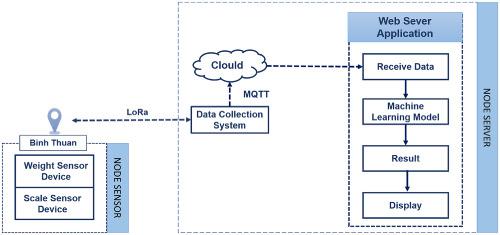当前位置:
X-MOL 学术
›
Int. J. Commun. Syst.
›
论文详情
Our official English website, www.x-mol.net, welcomes your
feedback! (Note: you will need to create a separate account there.)
Wireless sensor networks and machine learning meet climate change prediction
International Journal of Communication Systems ( IF 1.7 ) Pub Date : 2020-11-25 , DOI: 10.1002/dac.4687 Tran Anh Khoa 1 , Nguyen Quang Minh 2 , Hoang Hai Son 3 , Cao Nguyen Dang Khoa 2 , Dinh Ngoc Tan 2 , Nguyen VanDung 2 , Nguyen Hoang Nam 1 , Dang Ngoc Minh Duc 4 , Nguyen Trung Tin 5
International Journal of Communication Systems ( IF 1.7 ) Pub Date : 2020-11-25 , DOI: 10.1002/dac.4687 Tran Anh Khoa 1 , Nguyen Quang Minh 2 , Hoang Hai Son 3 , Cao Nguyen Dang Khoa 2 , Dinh Ngoc Tan 2 , Nguyen VanDung 2 , Nguyen Hoang Nam 1 , Dang Ngoc Minh Duc 4 , Nguyen Trung Tin 5
Affiliation

|
Climate change is one of the main challenges faced by the development of every country. For countries producing agricultural commodities, the climate affects the quantity and quality of products. Many methods have been proposed to keep track of climate. One traditional method is the weather station model, which indicates the temperature, wind speed, and direction and extent of cloud cover. However, this method of predicting climate change has low accuracy due to geographical variation, for example, mountainous or forested areas. Recently, a combination of wireless sensor networks (WSN) and machine learning (ML) has been considered for prediction with the Internet of Things (IoT), for instance, through a wireless body area network. For climate change prediction, we design and develop a control system that uses node sensors to collect data in sandhills and beaches, with data management conducted via a web application with three components. The first component is designed to collect data from the node sensors. The second component is mainly used to control the system through a web application. The third component uses linear regression in ML to analyze the data to predict weight and volume. The complete system has been tried and tested in real time on a 10‐m2 area of a beach at Binh Thuan province, Vietnam, where sensor node data were wirelessly collected over a cloud using a web application. This enabled assessment of the current state of the land at a coastal sandy beach, as well as prediction of the risk level of desertification and natural disasters.
中文翻译:

无线传感器网络和机器学习满足气候变化预测
气候变化是每个国家发展面临的主要挑战之一。对于生产农产品的国家而言,气候会影响产品的数量和质量。已经提出了许多方法来跟踪气候。一种传统的方法是气象站模型,它可以指示温度,风速以及云层的方向和范围。然而,这种预测气候变化的方法由于诸如山区或森林地区的地理变化而具有较低的准确性。最近,已经考虑了无线传感器网络(WSN)和机器学习(ML)的组合,例如通过无线人体局域网与物联网(IoT)进行预测。对于气候变化预测,我们设计和开发了一种控制系统,该系统使用节点传感器收集沙丘和海滩中的数据,并通过包含三个组件的网络应用程序进行数据管理。第一个组件设计为从节点传感器收集数据。第二个组件主要用于通过Web应用程序控制系统。第三个组件使用ML中的线性回归分析数据以预测体重和体积。完整的系统已在10分钟内进行了实时测试和测试越南平顺省海滩的2个区域,使用Web应用程序通过云通过无线方式收集传感器节点数据。这样就可以评估沿海沙滩的土地状况,并预测荒漠化和自然灾害的风险水平。
更新日期:2021-01-04
中文翻译:

无线传感器网络和机器学习满足气候变化预测
气候变化是每个国家发展面临的主要挑战之一。对于生产农产品的国家而言,气候会影响产品的数量和质量。已经提出了许多方法来跟踪气候。一种传统的方法是气象站模型,它可以指示温度,风速以及云层的方向和范围。然而,这种预测气候变化的方法由于诸如山区或森林地区的地理变化而具有较低的准确性。最近,已经考虑了无线传感器网络(WSN)和机器学习(ML)的组合,例如通过无线人体局域网与物联网(IoT)进行预测。对于气候变化预测,我们设计和开发了一种控制系统,该系统使用节点传感器收集沙丘和海滩中的数据,并通过包含三个组件的网络应用程序进行数据管理。第一个组件设计为从节点传感器收集数据。第二个组件主要用于通过Web应用程序控制系统。第三个组件使用ML中的线性回归分析数据以预测体重和体积。完整的系统已在10分钟内进行了实时测试和测试越南平顺省海滩的2个区域,使用Web应用程序通过云通过无线方式收集传感器节点数据。这样就可以评估沿海沙滩的土地状况,并预测荒漠化和自然灾害的风险水平。











































 京公网安备 11010802027423号
京公网安备 11010802027423号